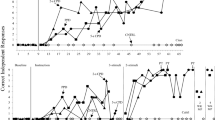Abstract
A lag schedule of reinforcement is one way to increase response variability; however, previous research has been mixed with regard to the necessary parameters to increase variability. For some individuals, low schedule requirements (e.g., Lag 1) are sufficient to increase variability. For other individuals, higher lag schedules (e.g., Lag 3) or a lag schedule in combination with prompting is needed to increase variability. We evaluated the efficiency of different within-session progressive lag schedules to increase response variability with 2 children with autism. Results showed that increasing the lag criterion across sessions increased variability to levels similar to beginning with a high lag schedule for one participant. When lag schedules did not increase variability for the second participant, we compared a variety of prompting procedures. Results of the prompting evaluation showed that a tact-priming procedure was effective to increase varied responding.






Similar content being viewed by others
References
American Psychiatric Association. (2013). Diagnostic and statistical manual of mental disorders (5th ed.). Arlington, VA: Author.
Betz, A. M., Higbee, T. S., Kelley, K. N., Sellers, T. P., & Pollard, J. S. (2011). Increasing response variability of mand frames with script training and extinction. Journal of Applied Behavior Analysis, 44, 357–362. https://doi.org/10.1901/jaba.2011.44-357
Brodhead, M. T., Higbee, T. S., Gerencser, K. R., & Akers, J. S. (2016). The use of a discrimination training procedure to teach mand variability to children with autism. Journal of Applied Behavior Analysis, 49, 34–48. https://doi.org/10.1002/jaba.280
Contreras, B. P., & Betz, A. M. (2016). Using lag schedules to strengthen the intraverbal repertoires of children with autism. Journal of Applied Behavior Analysis, 49, 3–16. https://doi.org/10.1002/jaba.271
DeLeon, I. G., Chase, J. A., Frank-Crawford, M. A., Carreau-Webster, A. B., Triggs, M. M., Bullock, C. E., & Jennett, H. K. (2014). Distributed and accumulated reinforcement arrangements: Evaluations of efficacy and preferences. Journal of Applied Behavior Analysis, 47, 293–313. https://doi.org/10.1002/jaba.116
Falcomata, T. S., Muething, C. S., Silbaugh, B. C., Adami, S., Hoffman, K., Shpall, C., & Ringdahl, J. E. (2018). Lag schedules and functional communication training: Persistence of mands and relapse of problem behavior. Behavior Modification, 42, 1–21. https://doi.org/10.1177/0145445517741475
Heldt, J., & Schlinger, H. D. (2012). Increased variability in tacting under a lag 3 schedule of reinforcement. The Analysis of Verbal Behavior, 28, 131–136. https://doi.org/10.1007/BF03393114
Lee, R., & Sturmey, P. (2014). The effects of script-fading and a lag-1 schedule on varied social responding in children with autism. Research in Autism Spectrum Disorders, 8, 440–448. https://doi.org/10.1016/j.rasd.2014.01.003
Lee, R., Sturmey, P., & Fields, L. (2007). Schedule-induced and operant mechanisms that influence response variability: A review and implications for future investigations. The Psychological Record, 57, 429–455. https://doi.org/10.1007/BF03395586
Napolitano, D. A., Smith, T., Zarcone, J. R., Goodkin, K., & McAdam, D. B. (2010). Increasing response diversity in children with autism. Journal of Applied Behavior Analysis, 43, 265–271. https://doi.org/10.1901/jaba.2010.43-265
Neuringer, A. (2002). Operant variability: Evidence, functions, and theory. Psychonomic Bulletin & Review, 9, 672–705. https://doi.org/10.3758/BF03196324
Page, S., & Neuringer, A. (1985). Variability is an operant. Journal of Experimental Psychology: Animal Behavior Processes, 11, 429–452. https://doi.org/10.1037/0097-7403.11.3.429
Phillips, C. L., & Vollmer, T. R. (2012). Generalized instruction following with pictorial prompts. Journal of Applied Behavior Analysis, 45, 37–54. https://doi.org/10.1901/jaba.2012.45-37
Rodriguez, N. M., & Thompson, R. H. (2015). Behavioral variability and autism spectrum disorder. Journal of Applied Behavior Analysis, 48, 167–187. https://doi.org/10.1002/jaba.164
Schwartz, B. (1982). Failure to produce response variability with reinforcement. Journal of the Experimental Analysis of Behavior, 37, 171–181. https://doi.org/10.1901/jeab.1982.37-171
Stokes, P. D. (1999). Learned variability levels: Implications for creativity. Creativity Research Journal, 12, 37–45. https://doi.org/10.1207/s15326934crj1201_5
Susa, C., & Schlinger, H. D. (2012). Using a lag schedule to increase variability of verbal responding in an individual with autism. The Analysis of Verbal Behavior, 28, 125–130. https://doi.org/10.1007/BF03393113
Wiskow, K. M., & Donaldson, J. M. (2016). Evaluation of a lag schedule of reinforcement in a group contingency to promote varied naming of categories items with children. Journal of Applied Behavior Analysis, 49, 1–13. https://doi.org/10.1002/jaba.307
Acknowledgements
We thank Batool Alsayedhassan for her assistance in collecting data.
Author information
Authors and Affiliations
Corresponding author
Ethics declarations
Conflict of interest
The authors declare that they have no conflicts of interest.
Ethical approval
All procedures performed in studies involving human participants were in accordance with the ethical standards of the institutional and/or national research committee and with the 1964 Helsinki declaration and its later amendments or comparable ethical standards.
Additional information
Publisher’s Note
Springer Nature remains neutral with regard to jurisdictional claims in published maps and institutional affiliations.
Electronic supplementary material
ESM 1
(DOCX 68 kb)
Appendix
Appendix
Tables 4, 5 and 6 are examples of sessions that consist of 3 different responses (Tables 7 and 8 consist of 6 and 10 responses, respectively); however, the average variability score is different based on the within-session response patterns.
Rights and permissions
About this article
Cite this article
Wiskow, K.M., Matter, A.L. & Donaldson, J.M. An evaluation of lag schedules and prompting methods to increase variability of naming category items in children with autism spectrum disorder. Analysis Verbal Behav 34, 100–123 (2018). https://doi.org/10.1007/s40616-018-0102-5
Published:
Issue Date:
DOI: https://doi.org/10.1007/s40616-018-0102-5




